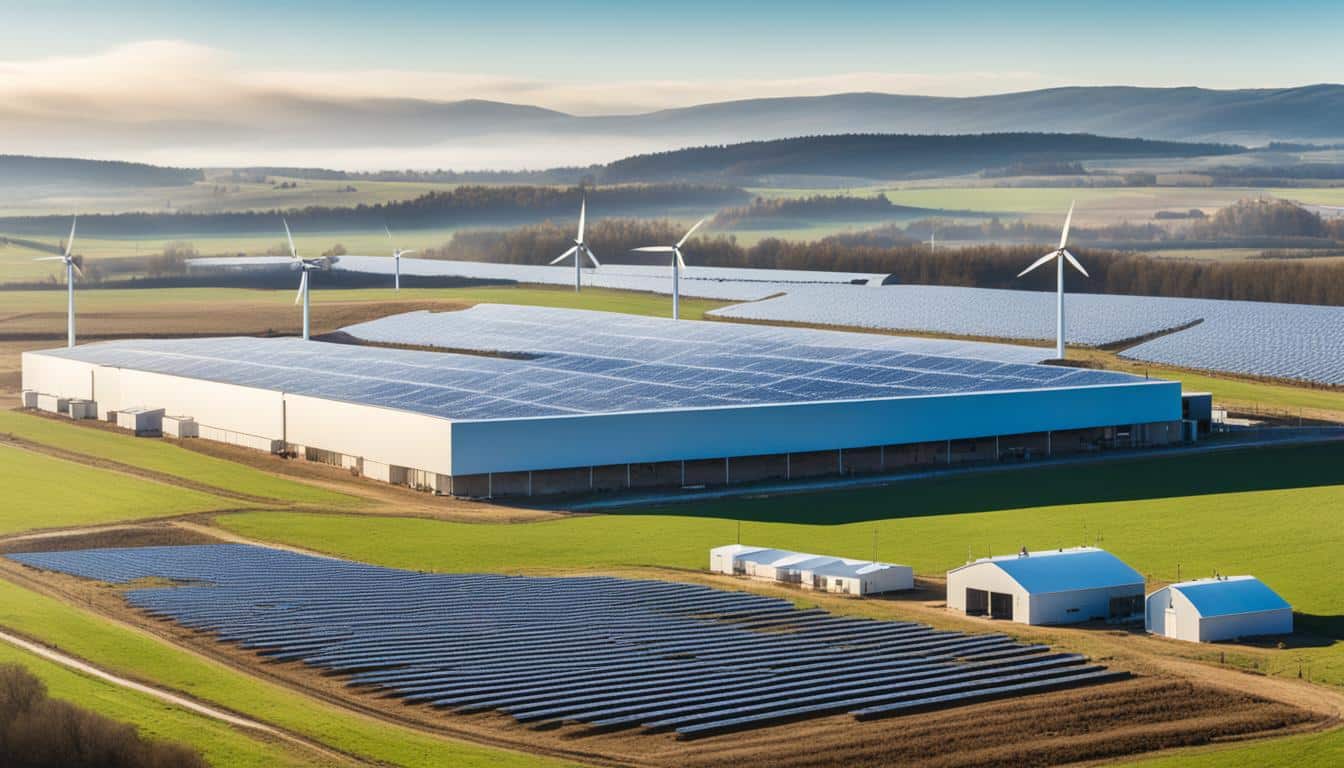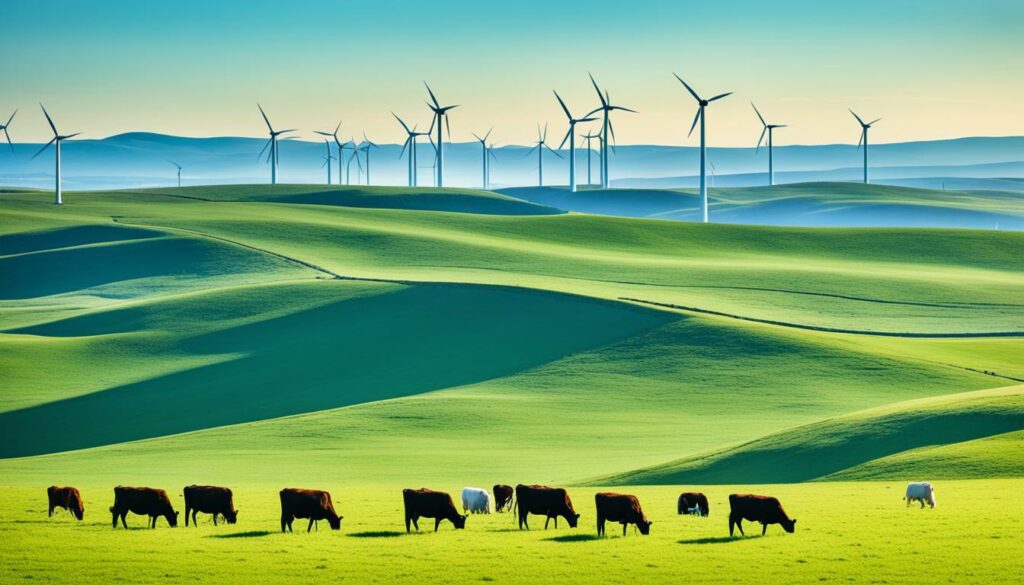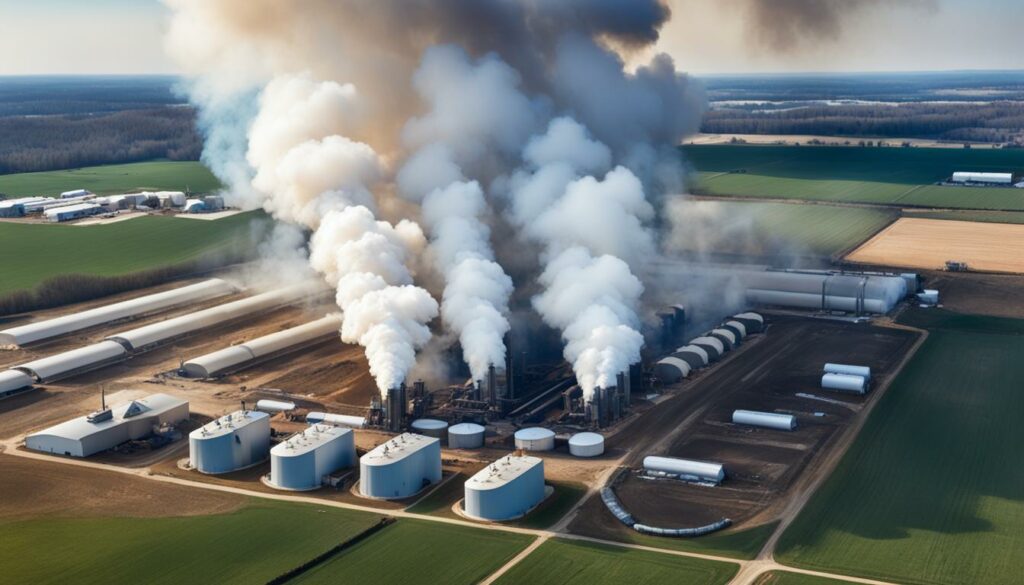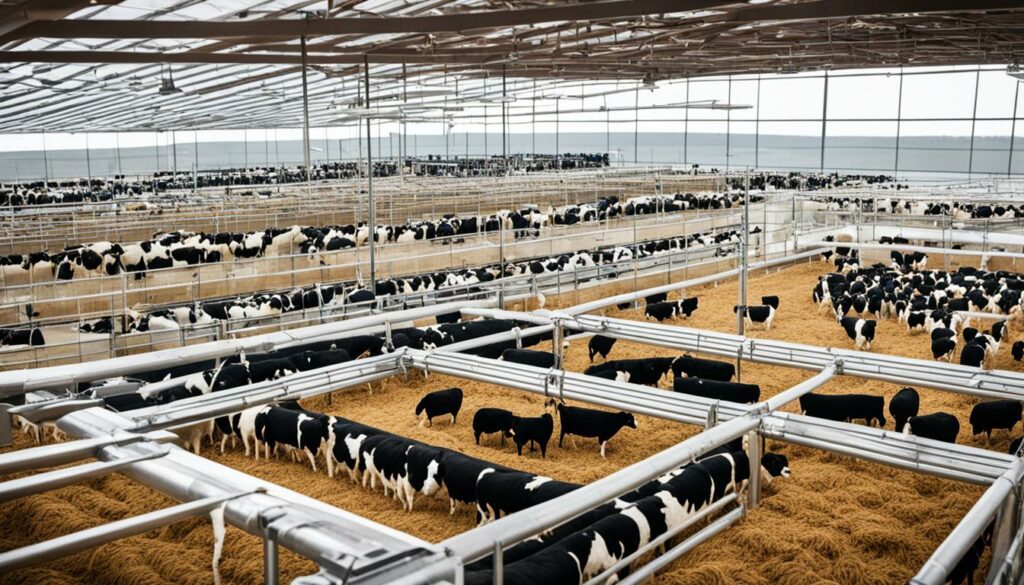Menu

The Clean Air Act, a key law since 1955, got a big update in 1970. It controls air pollution in the US. This law watches six pollutants, affecting many areas, including livestock farms. It’s key in fighting against bad air and health issues caused by farms with big numbers of animals.
One big issue in farming is the ammonia from these large farms. Studies show we can see an increase in ammonia from space, mainly due to the animals’ waste. This not only makes the air dirty but also can cause breathing problems. The rules around farming, especially air quality, aim to do more than stop pollution. They also want to make sure the rules are fair to everyone, particularly those who are poor and not White. Even gases like methane, which we can’t smell, are linked to health problems when mixed with other bad stuff in the air.
We really need to watch the air closely and make big efforts to cut down these dangers. Meeting the standards set by the Clean Air Act is a must for new farms, or ones that change a lot. These rules stop the farms from making air and health problems worse.
Looking after the environment while farming is all about finding the right balance. By following tough rules on the air, farmers can lessen harm to our surroundings and people. This way, we can have farming for food that is good for everyone and the Earth.
Livestock farming is key to the US economy, bringing in about $100 billion a year. About 1.3 million farms in the US raise animals and birds. This makes air quality regulations livestock farming very important because of the bad effects on the environment and our health from the gases produced.
Roughly, 238,000 farms are animal feeding operations (AFOs). Most of these are small, with less than 300 animals. But, the real impact on the environment happens in operations with more animals, known as concentrated animal feeding operations (CAFOs). These larger farms churn out a lot of harmful gases like ammonia and methane, which are really bad for the air.
Every year, AFOs in the US pump out about half of all ammonia from both natural and human-made sources. This ammonia links to poor air quality, seen through satellite data. The EPA also says more than 30% of the US’s methane comes from livestock, with their waste making up a big part of these emissions.
We must handle these emissions well to keep our air clean and healthy. Gases like hydrogen sulphide, ammonia, and others can make the air bad and be risky for our health. It’s why there are regulatory measures livestock emissions, guided by the government, to protect our health and the environment.
The Clean Air Act and CERCLA put rules on pollutants and ask for reports when these rules are violated. But, farming often gets some special rules because it’s hard to control gases spread over wide areas. In places like California, strict rules are laid out to fight air pollution in specific places, such as the San Joaquin Valley.
There are deep links between air and water quality, and laws also affect how well farms can do economically. The USDA helps farmers financially to reduce dust and control pollution. This shows the blend of following rules and making farming practices that are good for the environment.
The story of air quality rules links closely to farming. This is especially true with the Clean Air Act’s beginning and growth. This act has greatly influenced how air quality is measured, affecting how farmers work with their animals and land. Knowing this history helps us understand today’s rules for air quality in farming.

The Clean Air Act started in 1955, making a formal plan for clean air in the U.S. At first, it focused on letting states make and manage their pollution rules. But, it grew to include nationwide rules on which airs gases are too much, like ammonia and hydrogen sulfide.
Animal farming is worth around $100 billion yearly, so it faces a lot of rules due to its big air pollution. There are about 238,000 animal farms, with most being small, family-run places. But the bigger farms, the concentrated animal feeding operations (CAFOs), with more than 300 animals, have to follow very strict rules on air pollution.
Bodies like the EPA are key in making sure old air quality rules are followed. They set the National Ambient Air Quality Standards, which say how clean the air should be. They also need the states to make plans to cut down on the bad stuff in the air.
Smells, dust, and gases from farms can be bad for the air, like ammonia from animal waste. This makes up half of all ammonia in the U.S. Our animal farms also make a lot of methane, over 30% of the nation’s total. To keep the air clean, we need good plans for dealing with animal waste and controlling these gases.
| Pollutant | Source | Percentage of National Emissions |
|---|---|---|
| Ammonia | Animal Manure | 50% |
| Methane | Livestock | 30% |
| Nitrous Oxide | Manure Management | 5% |
Regulators work hard to keep farms meeting air quality rules. As farming changes, so do the rules. This change is important to fight new challenges in air quality because of the ways we farm now.
Livestock agriculture must follow strict rules to safeguard health and nature. It keeps a check on harmful gases from animal farms. These gases can include carbon monoxide, nitrogen oxide, and others. The goal is to meet national standards for air quality, benefiting everyone.
Since 1963, the Clean Air Act has been key to managing air pollution. It looks into six main harmful gases. States must make sure these gases don’t harm people or nature. They work to keep us healthy and the environment safe from dangerous chemicals like ammonia.
Where you are can change how strict these rules are. If an area doesn’t meet clean air rules, farms there may find it hard to expand. Each place must find ways to lower pollution without stopping farming. It’s a challenge as different areas face different rules.
| Pollutant | Health Impact | Environmental Impact |
|---|---|---|
| Carbon Monoxide | Reduces oxygen delivery to organs | Contributes to smog formation |
| Nitrogen Oxide | Respiratory issues | Acid rain formation |
| Particulate Matter | Cardiovascular and respiratory problems | Reduced visibility, soil acidification |
| Sulfur Dioxide | Respiratory illness, aggravation of existing heart disease | Acid rain, harms crops and ecosystems |
| Lead | Neurological damage, particularly in children | Contaminates soil and water |
Concentrated Animal Feeding Operations (CAFOs) are key in the US animal farming sector. They make a lot of money but also cause big problems for the environment. These operations keep many animals in a small area to make the most products.

A CAFO is a farm where many animals are kept in a small space. This way of farming became common in the 1950s for poultry and later for cattle and swine. Today, most meat animals in the US are raised in these large, crowded places.
There are nearly 20,000 CAFOs in the US. And from 2011 to 2017, over 1,400 new ones were added.
CAFOs create serious and various environmental issues. They produce about 133 million tons of manure each year. This is a lot more than the waste humans make.
CAFO waste can cause problems like algal blooms and disease from harmful bacteria. Plus, the antibiotics given to animals can lead to antibiotic resistance in people. Worse, the air near CAFOs can contain harmful chemicals that pollute our water and air. These issues affect both our environment and health. So, we need strong rules to lower these risks.
As more big farms and fewer small ones appear, CAFOs’ impact grows. This harms areas without good oversight of their environment. We must carefully watch and regulate these large farming operations to deal with their many issues.
Emissions from livestock are a big worry for air and health. Ammonia, hydrogen sulfide, and dust are key players. These emissions can cause breathing issues and even heart problems over time.
Livestock waste creates a lot of ammonia. It makes our eyes, nose, and throat sore. Too much can cause serious lung problems. Hydrogen sulfide from animals can lead to headaches and in rare cases, it can be hard to breathe.
Livestock and poultry on big farms produced huge amounts of waste in 2012, more than the people in the U.S. This shows how much these animals can pollute the air.
| Health Impacts | Substance | Emission Source |
|---|---|---|
| Respiratory issues | Ammonia | Livestock waste |
| Cardiovascular problems | Particulate matter | Animal feeding operations |
| Neurological effects | Hydrogen sulfide | Decomposition of organic material |
The long-term issues from these emissions are serious too. Dust causes a haziness in the air which is bad for health. Fixing these problems is important for the environment.
The livestock industry is a big part of greenhouse gas emissions. Pig and cattle methane has gone up by 37% and 50% in 15 years. This means we need strong rules to limit their impact.
Livestock and their emissions are a big problem for health and nature. Smart air quality rules are key to making things better for us all.
Livestock farming has to follow strict rules to control emissions. These rules are set by both national and local governments. They limit the amount and type of pollutants that can be produced. This ensures that farming methods are safe for the environment.
There are national laws, such as the Clean Air Act, that apply to everyone. Each state also has its own additional rules. The NRCS helps farmers put in place measures to manage nutrients on their land. In 2001, they helped with this on 5.4 million acres. The CRP is a choice for farmers to protect their land. Since 2002, more farmers have joined, increasing the protected land from 36.4 million to 39.2 million acres.
| Measure | Details |
|---|---|
| NRCS Nutrient Management | 5.4 million acres in 2001 |
| CRP Enrolment | Increased from 36.4 million to 39.2 million acres in 2002 |
| FSA Service Centres | 2500 USDA-operated centres |
New tech is key for controlling emissions. It helps meet requirements and supports new ideas at the state level. In 2001, the NRCS set up 10,500 waste systems. This shows how tech is helping to reduce pollution from livestock.
A guide was published in September 2017 to help with emission control. This guide explains the rules and how to use technology for better farming. It’s all about using the latest methods to manage pollution.
“The adoption of technological advances in emission control not only ensures compliance but also significantly mitigates the adverse effects of livestock farming on air quality.”
The guide covers topics like Animal Confinement, Manure Management, and Land Application. It offers solutions to reduce emissions from farming. Technology is always improving to make farming safer for the planet.

Air quality rules greatly affect the livestock industry’s finances. Meeting these guidelines requires farmers to invest in new technologies. These aim to cut down on harmful emissions. Although these changes cost money at first, they can bring about many advantages over time.
For farmers, sticking to these rules means spending on new gear and better waste management. Also, they might need to change how they operate. In the U.S., farming caused $230 billion in air pollution harm in 2014. That’s more than the utility sector. While tools like ammonia scrubbers help, they can be too pricey for some small farms.
Yet, following air quality laws can lead to big win-wins. One major plus is better public health. In the U.S. alone, dealing with health issues from air pollution costs $820 billion a year. It also causes 107,000 premature deaths yearly. Cutting air pollution can lower these medical bills significantly. It also means fewer sick days off work, globally saving up to 1.2 billion days a year. This could reach 3.8 billion by 2060.
Plus, making our air cleaner helps save money and the environment. In the U.S., cleaning the air shows a 30:1 ratio of benefits to costs. This proves that having clean air is worth a lot. For instance, making the air in China just a bit cleaner could save $9.2 billion in health costs every year. These facts show it’s crucial for the livestock industry to find a balance. This means looking after the environment without sacrificing their financial growth.
Today, environmental justice in the livestock industry is a key concern. It’s a big issue, especially for those hit harder by harmful farming practices. Across the U.S., Right-to-Farm laws were put in place to help farmers. But, they often lead to serious environmental and health issues for people living in poorer or mainly non-White areas.

Back in the past, farm policies encouraged farms to get bigger. This led to many large farms, now helped by Right-to-Farm laws. In places like North Carolina, there are almost as many pigs as people on these huge farms. They create about 10 billion gallons of pig waste each year, which harms the air and water nearby.
Studies show a link between big farms and health problems. For example, in North Carolina’s rural areas, schools close to these farms see lots of kids diagnosed with asthma. The same is true in California’s San Joaquin Valley, which is 49% Latinx. One in six kids there has asthma because of the farms. This makes it clear that we need to rethink how farming laws affect communities.
We need policies that promote fair farming without harming communities. They should focus on sharing the good and bad effects of farming better. Everyone, including the people living near the farms, should help make these rules. And we must make sure the air and water are always safe, no matter where people live. Approaching the issue this way will protect those who are most at risk.
We’ve listed some important numbers and what they mean for the environment and our communities below:
| Statistic | Implication |
|---|---|
| Every state in the U.S. has Right-to-Farm laws | These laws often protect large farming operations at the expense of community health and the environment. |
| 10 billion gallons of pig waste in lagoons (North Carolina) | Severe water contamination, air pollution, and adverse health outcomes for nearby residents. |
| 17,900 air quality-related deaths per year (U.S. agriculture) | Highlights the significant public health toll of agricultural emissions. |
| 75% Latinx population affected (San Joaquin Valley) | Disproportionate health impacts, including high asthma rates, tied to agricultural practices. |
| 65% Latinx in Tulare County with double miscarriage rates | Elevated environmental risks and health impacts linked to high farming activity. |
| Nitrate-contaminated water costs 3x higher | Financial burdens on communities already facing water quality issues from agricultural pollutants. |
Keeping an eye on what farm animals release into the air is tough. This makes knowing the exact effects hard, especially across the whole farming sector. With animal farming being a major business in the US, figuring out how much they pollute is very complex.
We face challenges due to technology when tracking animal emissions. There are ways to measure these emissions from afar or close up. But, they don’t always work well, especially in places with lots of animal farms.
Most of these farms are quite small. They might not have the money to spend on the latest monitoring gadgets. As a result, keeping an accurate eye on emissions can be hard for them.
Getting the data right is crucial for dealing with the pollution from farm animals. This information finds where the pollution comes from and how bad it is. It shows, for example, that animal waste makes up a big chunk of harmful gases in the US.
But, without perfect numbers on emissions, it’s difficult to lower pollution. We need ways to check the air that are trusted and don’t cost too much. This is so both small farms and big ones can follow the pollution rules easily.
Dealing with farm animal emissions needs everyone to work together. This includes government agencies, those who make new tech, and farmers themselves. Keeping the air clean isn’t only about following the rules but also about protecting our environment and health.
Many success stories show how livestock farmers handle regulations well. By using new methods and tools, they make sure their farms meet rules without problems. For example, some research found that cows who faced heat stress while still in the womb can better manage heat later. This is important as the world gets warmer.
In Bangladesh’s Kalapara area, people have found clever ways to fight salt in the soil. This has helped keep farming and fishing alive. They use a special type of grass that helps cows eat better and stay cooler. This strategy keeps the animals healthy even with the tough environment (Aldrich et al., 1993).
Over in Egypt, raising small animals like goats and sheep has really helped locals. This shows that having a variety of animals can make a big difference. These cases highlight how doing things the right way can be good for the planet and the farmer’s wallet too.
When we talk about climate change, there are big challenges all over. From issues with moving grain in America to a drop in grass quality due to more CO2, it’s clear we need strong rules. These stories show how using smart farming can protect our future. They help guide what we should do next to make farming sustainable.
Air quality regulations for farms look at ammonia, nitrous oxide, methane, and particulate matter. They affect air quality and public health.
The Clean Air Act sets rules for pollutants like ammonia and hydrogen sulfide in farming. It makes states create plans to cut emissions. This affects how farms operate.
CAFOs raise many animals and are key in US animal agriculture. They release pollutants such as ammonia and hydrogen sulfide. Their large scale can harm the environment if waste is not managed well.
Emissions from farms can lead to breathing and heart problems. Particulate matter is also a central health concern. It can cause long-term environmental and health issues.
Advanced waste management, air scrubbing, and precision farming are used to cut emissions. These help farms follow rules and lessen their impact on the environment.
Farms face costs in meeting air quality rules. They might have to invest in new tech and alter methods. But, keeping the air clean offers health benefits and environmental protection.
Farm emissions can hit low-income and non-White areas harder. Policies should make sure everyone shares environmental impacts and benefits fairly. This is to protect all under air quality rules.
Good data is key to understanding farm impacts and lowering them effectively. However, current tech fall short in gathering enough data. We need better tools for precise monitoring.
Farmers are using new strategies and tech to reduce emissions and stick to rules. Success stories show that good environmental practices in farming are possible and beneficial.